Abstract
Web accessibility is becoming a relevant topic with an increased number of people with disabilities and the elderly using the web. Numerous legislations are being passed that require the web to be universally accessible to all people, regardless of their abilities and age. Despite this trend, university curricula still teach traditional web development without addressing accessibility as a topic. To investigate this matter closely, we studied the syllabi of web development courses at one university to evaluate whether the topic of accessibility was taught there. Additionally, we conducted a survey with nineteen students who were enrolled in a web development course, and we interviewed three lecturers from the same university. Our findings suggest that the topic of accessibility is not covered in web development courses, although both students and lecturers think that it should. This generates lack of competence in accessibility. The findings also confirm the finding of previous studies that, among web developers, there is a low familiarity with accessibility guidelines and policies. An interesting finding we uncovered was that gender affects the motivation to learn about accessibility. Females were driven by personal reasons, which we attribute to females having an increased sense of empathy. Finally, our participants were divided in their opinions whether accessibility contributes to usability.
Keywords:
accessibility; disability; education; curriculum; web development; web design; web programming; usability 1. Introduction
People with disabilities and the elderly are increasingly engaging in online learning as well as browsing the web to get access to information for their daily activities [1,2]. It is estimated that the community of the disabled consists of approximately 15% of the world population [3]. In addition, with the growing life expectancy, the community of the elderly is also increasing, and many disabilities are due to natural aging. For instance, according to the United Nations, by 2050, the population of 65 years and older will be 17%, compared to 9% in 2019 [4]. Therefore, it is a paramount necessity to make the web accessible in order to accommodate these communities.
The most common way to make the web accessible is by considering and applying the Web Content Accessibility Guidelines 2.1 (WCAG 2.1) [5], which provide guidance to make content accessible to all people, regardless of their disabilities. Early studies have suggested that teaching such guidelines along with techniques and tools to make the web accessible is an appropriate topic for Information Technology (IT) related courses [6]. Additionally, considering that at least 70% of websites are currently inaccessible and continuously in decline [7], the topic of accessibility should be addressed early on and become a standard part of IT-related curricula [6].
Other studies have suggested that accessibility should not only be taught as an additional topic to existing courses, but it should be closely incorporated with aspects of web design to achieve universal access by all users, including people with disabilities [8,9]. Unfortunately, “most software designers and engineers are not taught about accessibility in courses” [10], although it is recognized as a necessary knowledge for students in computer science [11].
The inclusion of accessibility in a university curriculum within web development courses was first suggested by the IT2008 Model Curriculum published by the Association for Computing Machinery (ACM) [12]. A study reported that web designers with competence in solving accessibility problems are more employable [13]. Moreover, with the growing number of worldwide standards regarding accessible technologies, the demand has increased for skills in accessible technology development [13]. Additionally, a study suggested that integrating accessibility into teaching could attract female students to IT-related sciences [14]. Lately, big companies, such as Facebook, are expecting computer science students to know about accessibility, as they demand this knowledge in their job descriptions indicated as “User Interface (UI) design principles and accessibility best practices” [11].
To further investigate this topic, we looked at one university in Sweden as a case study to measure the extent that the topic of accessibility is being taught in web development courses. We conducted the study by initially exploring university curricula from this university. Then, we administered surveys with students taking a web development course, and we conducted interviews with teachers of courses at the same university. Our aim was to investigate whether the topic of accessibility is considered important for students taking and teachers lecturing web development courses and whether they consider that the topic should be taught within such courses. In the next sections, we provide an overview of related work and accessibility policies, guidelines, and software. We then present our approach, followed by results and their discussion. In the end, we provide conclusions, as well as future directions for this study.
2. Related Work
Since early 2000, there have been a number of attempts to integrate accessibility in computer science curricula [6,7,8,10,13,15,16] by advocating that the topic of accessibility should be integrated in a number of courses and programs [6]. For example, the accessibility-first pedagogy for web design courses highlights that accessibility should be a topic of interest to computer scientists [8]. An attempt to present a number of accessibility approaches for computing programs, specifically for web design courses, was seen as a fundamental instrument [13]. Another research study [16], discussed the raising importance of universal access to design for the needs of widest range of users.
Covering the topic of accessibility as an integral part within and beyond undergraduate courses has also been advocated [15]. For example, the introduction of accessibility as a cross topic in several engineering degrees has been studied [17], and one of the latest attempts was to motivate lecturers to teach accessibility in several computer science courses [10].
Despite the fact that these studies have stressed the importance of accessibility for many years, the basic concepts of accessibility are still not typically taught within IT-related degrees [16]. Occasionally, they are taught briefly within courses such as interaction design [16] or human computer interaction [18,19,20]. In some universities, such as at Carnegie Mellon University [20] and University of Dundee [15], accessibility is offered as a separate course. The most comprehensive course that covers accessibility is offered by George Mason University [13]. In their paper, the authors reported a detailed plan that consisted of eleven lectures, along with the assessment methods. The course, which is called Multimedia and Web Design, is offered to bachelor students. The accessibility aspects are taught within each lecture, which helps students to consider accessibility as an intrinsic part of the web development process. Consequently, accessibility is taught as a goal from the beginning and not as an activity that is perceived as additional to the process of web development.
In Sweden, the disability policy was initiated in 2000 and revised in 2010 with the goal of enabling people with disabilities to have power and influence over their everyday lives [21]. This government initiative, called “From Patient to Citizen,” aims to consider people with disabilities as citizens with the same rights as everyone else. This initiative, however, has only partially penetrated the aspects of teaching accessibility in university settings. In 2003, an Aging and Design Program started at Lund University that aimed at researching the involvement of the elderly persons in design. In 2007, at Luleå University, Design for All courses were offered to architects. A similar program was also offered in Mid Sweden University in 2010 [22]. These programs, however, are just isolated efforts in various fields and do not represent a satisfactory situation. Inaccessibility problems are still encountered today, even with the number of attempts mentioned in above studies. In addition, most of the universities in Sweden still lack accessibility courses or at least modules in relevant courses, such as web development.
3. Brief Overview of Accessibility Policies, Guidelines and Software
Web accessibility policies and laws are continuously being enacted to ensure guaranteed inclusive services to marginalized groups. Each country devises its own policies and laws that impose requirements to public and private sector. A comprehensive list of laws and policies are provided in [23]; however, for our context, we will just briefly describe the EU and Swedish policies.
The European Accessibility Act [24] concerns both the public and private sectors, and it describes accessibility requirements for products and services. The member states of the EU must implement this directive into their national law by June 2022, whereas compliance must be achieved by June 2025.
In Sweden, there is the Discriminatory Act [25], which was enacted in 2008 that affects the public and private sector. The Act is quite broad and involves discrimination, harassment, and disability in the work and educational life.
These directives and acts typically serve to raise the awareness and the necessity for compliance, but to fulfill those requirements, guidelines are needed. The Web Accessibility Initiative (WAI) [26] of the World Wide Web Consortium (W3C) has developed standards and guidelines to help developers and designers implement accessibility in their products and services. The WAI consists of three parts:
- Web Content Accessibility Guidelines (WCAG) [5], which provide standards for web content accessibility and describes how web content could be made accessible for people with disabilities.
- Authoring Tool Accessibility Guidelines (ATAG) [27], which include software and services that developers and designers use to create web content.
- User Agent Accessibility Guidelines (UAAG) [28], which describe how user agents, such as browsers and media players, are accessible to people with disabilities.
To support developers and designers in achieving the accessibility of their websites, besides guidelines, accessibility software can be utilized. Typically, these are evaluation tools that assist developers in measuring the level of accessibility of web content. They help in quickly finding accessibility errors and provide guidance on how to solve those errors. Some of these tools automatically check for problems and then provide the developers with a detailed report. Other tools provide a wizard-based evaluation that guides developers through steps. These tools are developed by companies, universities, and even individuals. An extensive list of such tools is provided in [29].
4. The Study Context and Approach
To understand if the topic of accessibility topic is introduced in web development courses, we initially looked at 14 different courses that are offered in one of the universities in the south of Sweden. The analysis involved looking at the syllabi of the courses, shown in Table 1.

Table 1.
Web development courses that were analyzed in relation to accessibility.
Out of 14 courses, only two of them, the “Media Technology: Web Publishing” and “Media Technology: Web Production,” which are quite similar content wise, have a topic related to accessibility. The exact phrasing of both course contents used was “usability and accessibility on websites.” When we asked the teacher of these courses, his response was that he covers the topic of accessibility within one lecture, although he mostly covers usability. Additionally, he introduces screen readers and the potential of modern web technologies, which provide mechanisms to adapt to different screens. However, when asked if he introduced any standards and guidelines or even Swedish laws related to web accessibility, the teacher said that he does not mention any specific standards or guidelines. This insight encouraged us to design this research study to explore why the topic of accessibility is still-missing among web development courses and also to investigate what can be done to address this problem, both from students’ and teachers’ perspectives.
Study Approach and Participants
As part of the exploratory nature of this study, we utilized both quantitative and qualitative approaches. We utilized a mixed approach via a survey and semi-structured interviews as the data collection method. In total, 19 student participants responded to our survey, and three teachers were interviewed, as presented in Table 2.

Table 2.
Participants and data collection.
The survey was distributed to students who were enrolled in the “Introduction to Web Programming with JavaScript” course (see survey questions in Table 3). The aim of this survey was to understand if web programing students are familiar with web accessibility aspects. Additionally, we wanted to learn about their awareness of the standards and principles in designing accessible websites that ensure that end users have equal access to information and functionality, independent of their level of disability. Participants were second year bachelor level students from the department of Computer Science and Media Technology. The three interviewed teachers were lecturing the following courses: “Media Technology: Web Publishing,” “Media Technology: Web Production,” and “Introduction to Web Programming with JavaScript.” The aim was to get additional insights by exploring teachers’ perspectives (see interview questions in Table 4). This data collection served as a means for us to see if the topic of web accessibility should be offered within the current web development and design courses or if it should be delivered as a new course. Our survey and interview questions were mainly based on the study of [30].

Table 3.
Survey questions.

Table 4.
Interview questions.
5. Results and Discussion
The process of data analysis began by organizing all the collected data, which consisted of surveys with students and interviews with teachers. We initially read all interview notes and cumulatively put those into digital post-it notes. Overall, seven post-it notes highlighted the answers given by interviewing three teachers. These are shown in the first dotted rectangle in Figure 1.
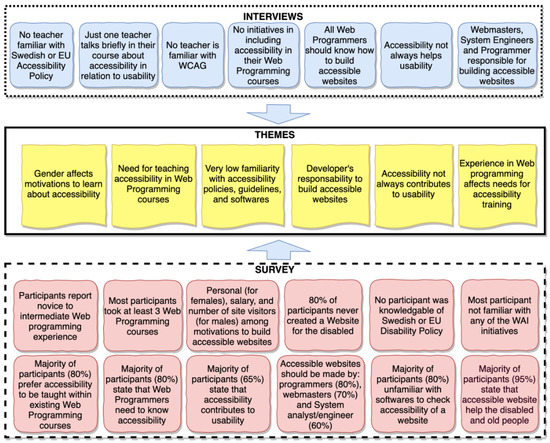
Figure 1.
Affinity diagram of the process of developing emerging themes from interviews and survey responses.
In a similar fashion, we generated post-it notes for the survey results. Overall, twelve post-it notes were created that cumulatively represented student responses; these are shown on the bottom dashed rectangle in Figure 1. The analysis process moved forward by identifying emerging themes between the interviews and surveys. The outcomes were six themes that are shown in post-it notes within the middle solid rectangle in Figure 1. We now describe in detail each of these themes and link to answers that were obtained from the surveys and interviews.
5.1. Gender Affects Motivation to Learn About Accessibility
Participants taking the survey were gender-balanced with 53% males and 47% females. It was thus possible to track any patterns that could be attributed to gender. When investigating the factors that could influence participants to build accessible websites, we found that female participants were driven by personal motivations, whereas male participants were driven by economy (salary, number of site visitors, etc.).
As it can be seen in Figure 2, four females and one male noted personal reasons, whereas one female and four males noted economic reasons, such as salary and website traffic. Other factors, such as the type of project and easy framework to implement accessibility features, were equally noted by both genders. Some comments provided by participants included:
Student 4 (Female): “For personal reasons, in order to become a better programmer.”
Student 5 (Female): “The need to make the website accessible by as many persons as possible.”
Student 8 (Male): “Number of visitors.”
Student 3 (Male): “Good salary.”
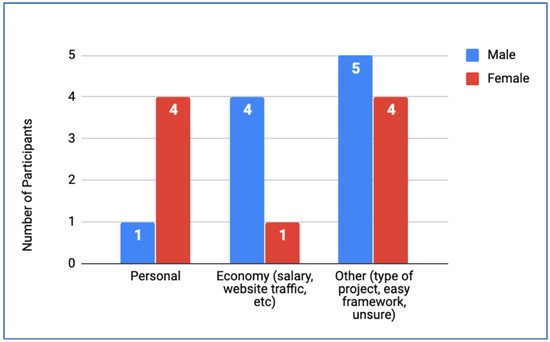
Figure 2.
Reasons affecting motivations to learn about accessibility shown by gender.
In order to better understand this gender effect, we found other research highlighting similar differences. The authors of [31] reported that females are twice as likely to engage in teaching accessibility within their courses and are proponents of the idea that accessibility as a topic should be covered in IT curricula. We believe that the fact that females are driven by personal reasons has to do with their higher level of empathy. The authors of [32] showed that women have higher self-reported higher levels of empathy compared to men. According to another study [33], which investigated the gender gap in charitable giving, women give more to poverty relief events compared to men. The effect was attributed to women having higher empathy levels than men. Similarly, women have been shown to have higher concern towards both the wellbeing of animals and environment protection [34].
5.2. Need for Teaching Accessibility in Web Programming Courses
The interviews revealed that only one teacher briefly included the topic of accessibility in their web development course. Despite the fact that teachers do not currently have an actual strategy or plan to include accessibility more extensively in their courses, all teachers maintained that all web programmers should know how to build accessible websites. When students were asked about the need to learn about accessibility, the majority of them (15 out of 19) stated that accessibility should be included for a couple of hours in a web development course. Three (out of 19) participants stated that accessibility should be a separate course in a program, whereas only one participant (out of 19) stated that there is no need for a such course (Figure 3). Some comments from teachers included:
Teacher 1: “Yes, every home page should comply. […] Since this is the first course, it is hard for them to grasp the idea, but first [students should learn to] code, then agile and usability, and [finally] a little accessibility. […] Everyone should have knowledge.”
Teacher 2: “…accessibility could be included in design-oriented web development courses, but not programming courses, like PhP.”
Teacher 3: “There should be some inclusion [in web development courses].”
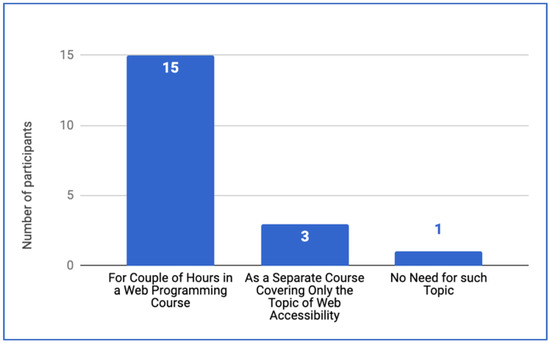
Figure 3.
Accessibility needs to taught to web programming students.
Similar findings have been reported in other studies. The authors of [8] reported teachers’ and students’ attitudes towards the inclusion of accessibility as a topic within courses; teachers maintained that it is necessary and also easy to include accessibility topics into the courses they teach, and students saw accessibility not as an addition but as an essential and intrinsic part of the website development process. Similar positive attitudes were reported in a study conducted with library and information science faculty and students [35]. Moreover, the authors of [15] provided guidance on how accessibility could be included in an entire study program by adding progression parts within most courses. However, despite these positive attitudes and guidances, concrete steps for the inclusion of accessibility in courses is lacking. We also noticed this when interviewing teachers in our study. The lack of expertise available to teach such courses is seen as one of the barriers to such [31].
5.3. Experience in Web Programming Affects Needs for Accessibility Training
While more closely investigating the need for teaching accessibility in web programming courses, we noticed a slightly different pattern between novice and intermediate participants. Their web programming experience was self-reported in the survey.
As shown in Figure 4, all novice participants stated that the topic of accessibility should be covered for few hours in existing web development courses. Intermediate participants, however, were almost split; five stated that accessibility should be covered within a web development course, whereas three stated that it should be a separate course. This showed the tendency that as people get more experience in web programming, they recognize the importance of accessibility. Interestingly, although not depicted in Figure 4, the three participants in favor of teaching accessibility as a separate course were all in the age range of 18–24, whereas the other two participants with intermediate experience who stated that accessibility should be included within a web development course were in the age range of 25–35 and 36–45. Though these are too limited data to indicate a general conclusion, there is a pattern that accessibility is recognized as a value more with younger people who get more web programming experience. Participants only provided close-ended answers to this question.
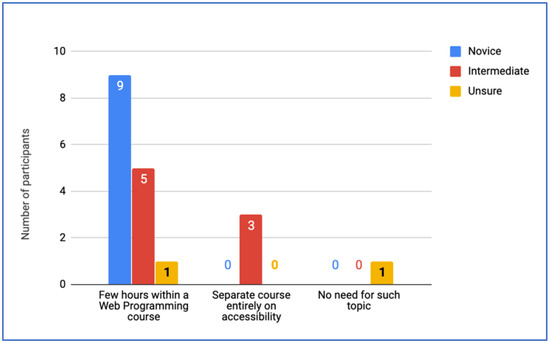
Figure 4.
Preference of teaching the topic of accessibility in courses.
In a similar study [36] that was conducted in Brazil, the need for accessibility training was highly emphasized by participants that work professionally in web development. These participants stated that accessibility was not included in their education, but they got educated on their own due to the necessity of implementing projects. Thus, in order to maintain the importance of accessibility, the topic should be included in mainstream education [37]. According to a recent survey that was conducted with 1857 participants, only 20% of faculties within computing programs teach accessibility in their courses [31].
5.4. Very Low Familiarity with Accessibility Policies, Guidelines, and Software
People in IT fields are not generally familiar with policies, and such were the results in our study. The interviews showed that none of the teachers were familiar with Swedish or EU accessibility policies. Similar findings were observed for student participants, who, as shown in Figure 5, had no familiarity with disability policies. Slightly positive answers were reported for familiarity with accessibility checking tools, which are tools that enable people to evaluate and measure the accessibility of a website. Only four people (out of 19) reported that they were familiar with such tools.
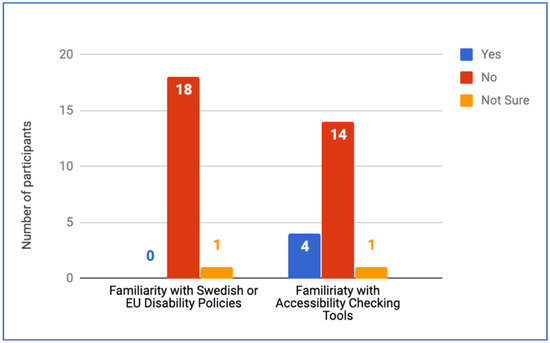
Figure 5.
Familiarity with disability policies and accessibility software.
Teacher 1: “I am not familiar with any disability policies or guidelines. [As for tools,] I am only familiar with tools to analyze the content and websites for color blind and people that have lower ability to see.”
Teacher 2 and 3: “Not familiar with any disability policies, guidelines or software.”
Similar findings were seen regarding the familiarity with accessibility guidelines. We asked participants about their familiarity with any of the WAI guidelines, namely WCAG, ATAG, and UAAG. As shown in Figure 6, most of the participants (11 out of 19) were not familiar with any of the guidelines, whereas 5 (out 19) were familiar with WCAG, 3 (out 19) were familiar with ATAG, and only one (out 19) was familiar with UAAG. Note that participants could select more than one choice. Similarly, no teacher was familiar with these guidelines. This result indicates the low knowledge that the participants possessed about guidelines that are necessary to adhered to in order to develop or evaluate accessible websites.

Figure 6.
Familiarity with accessibility guidelines.
Our results differ from those found on [30], where the majority of respondents noted that they were familiar with laws and regulations for accessibility. However, regardless of their knowledge on laws and regulations, the study also reported that implementing such knowledge was low in terms of actually developing accessible websites. The same held for familiarity with software tools for checking the accessibility of websites. Despite the majority of them being familiar with such software, their utilization was not comparable to participants’ knowledge.
Another result that was different in our study compared to those of [30] was the familiarity of the respondents with WAI guidelines. In our case, the majority of our participants were not familiar with any of the WAI guidelines, whereas the authors of [30] reported that the majority of respondents were familiar with WCAG (64%) but not with other guidelines (ATAG and UAAG). Perhaps these differences are due to diverse audiences participating in these studies; our participants were students, whereas in [30], participants were professional developers. More other studies are in line with the results of our study. For instance, the authors of [38] reported that only 16% of the participants were familiar with WCAG, and 13% and 7% were familiar with ATAG and UAAG, respectively. A lack of knowledge about WCAG among web developers has continued to be the trend, even in more recent surveys [39,40].
5.5. Developer’s Responsibility to Build Accessible Websites
Generally, the findings reveal a consistency between teachers and students. In the question on who should be responsible to ensure that websites are accessible, both groups reported that the responsibility mainly lies with programmers, webmasters, and system analysts/engineers. There were few participants who stated that the responsibility also lies with help desk managers and disability compliance office. The actual numbers are shown in Figure 7. Note that participants could select more than one choice. Some comments in relation to this question included:
Teacher 1: “Webmasters, programmers, and system analysts/engineers are responsible because if you want to have a perfect system, everyone should be involved.”
Teacher 2: “Webmasters and programmers, because accessibility encompasses many things, logical sequence on how various things are done, someone must have a good overview on these things, particularly the webmaster.”
Teacher 3: “Webmasters, programmers, and system analysts/engineers are responsible since they are most involved in creating websites.”
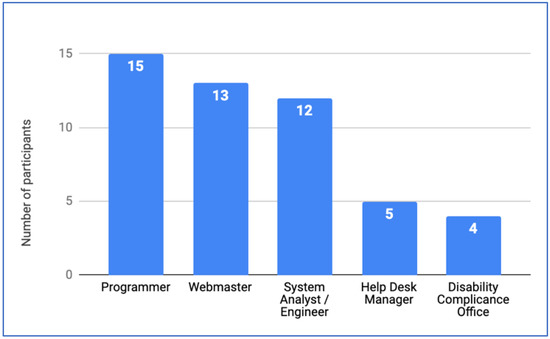
Figure 7.
Responsibility for the accessibility of websites lies with.
The majority of participants stated that it is the responsibility of web programmers and webmasters to build accessible websites, which is similar to the results of [30]. A slight difference was that in our study, more responsibility was given to the web programmer than the webmaster, which was the opposite of the results of [30]. There is a subtle difference between the role of a web programmer and a webmaster, the former being the person coding the front and back end of a website and the latter having a more extended role with additional responsibilities such as content creation and management, system administration, and design. Since these two roles could very often be perceived as similar, especially in smaller companies, perhaps we could assume that respondents in our study and the respondents of [30] did not see a significant difference between these two roles.
5.6. Accessibility Not Always Contributes to Usability
One teacher briefly discusses accessibility in his web programming course. He does that by relating it with usability, as he maintains that accessibility and usability are correlated and contribute to each other.
Teacher 1: “I am not differentiating between usability and accessibility. I teach them together, but the focus is more on usability.”
A similar stance was also observed among students; 12 (out 19) stated that accessibility increases usability, one participant stated the opposite, and the rest (6 out 19) were unsure (Figure 8).
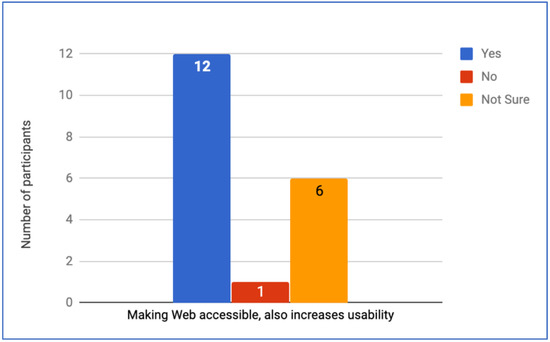
Figure 8.
Accessibility contributes to usability.
The positive correlation between accessibility and usability was not shared by two other teachers. They maintained that it is not always true that when we make a website accessible, we also increase its usability. These are some of their comments:
Teacher 2: “In some cases making websites accessible, can affect the other users. […] for example, if you increase the font size, it can negatively affect other [type of] users.”
Teacher 3: “Websites that are accessible can also be convoluted with too many options.”
Similar to our student responses, the authors od [41] reported that the majority of their respondents stated that accessibility and usability are highly related. A positive relation between accessibility and usability has been reported in other studies, although one study treated accessibility and usability elements as distinct but influencing each other [42], and the other considered accessibility as a subset of usability [43].
6. Conclusions and Future Work
In this paper, we conducted a case study about to the topic of accessibility at one university in Sweden. We used surveys and interviews as an approach to study the still-missing topic of accessibility within many web development courses. We measured the level of accessibility being taught in web development courses with the aim to investigate if the topic of accessibility is considered important for students and teachers who are involved in such courses. The affinity diagram helped us uncover emerging themes from interviews and survey responses. This process consequently helped us structure the results and uncover insights.
One of the main results showed that accessibility should be included in web development courses. This view was strongly maintained by both groups, students and teachers. The most interesting finding, although derived as a secondary result, was related to gender and its connection to accessibility. Our survey results showed that gender affected motivation to learn about accessibility. Specifically, female participants were driven by personal motivations, whereas males were driven by economy when considering accessibility. Unfortunately, all participants in our interviews were male, so we could not track any gender effects as we could with the surveys. This limitation, we believe, had implications on our results and particularly in the generalizability of this theme.
Additionally, we discovered that experience in web programming affected the needs for accessibility training. For example, as people gain experience in web programming, their perception about the importance of accessibility training also increases. Unfortunately, our results showed that there is still very low familiarity with accessibility policies, guidelines, and software. For example, the majority of participants had no familiarity with disability policies including Swedish or EU accessibility policies. This, however, confirms other studies in this topic. Regarding the responsibility of who should build accessible websites, the results showed that this responsibility mainly lies with programmers, webmasters, and system analysts/engineers. Our study also showed that accessibility does not always contribute to usability.
Our study’s conclusion confirmed findings that have been uncovered in other similar studies, such as the need for accessibility training, the lack of competence in accessibility, and generally the low familiarity with accessibility guidelines and policies. We did, however, uncover interesting gender effects in relation to accessibility, which we attribute to females having an increased sense of empathy.
It is a prominent outcome of this study that raising awareness for accessibility training is necessary. Calls to address this need have been directed to governments [44] and universities to offer training and support and to equip future developers with skills demanded by the market [45]. One of the authors participated in a workshop that was recently held at a university in the south of Sweden. Ten universities from Sweden, Denmark, Finland and Norway took part to discuss web accessibility in higher education. It was obvious that each university was struggling to find a way to include accessibility in their courses and curricula.
One of the main limitations of our study was its connection to one university only, which might affect the generalizability of our results, although most of the results confirmed previous work conducted on this topic [30,31,38,39,40]. Another limitation is that we only had 19 respondents, which might pose some threats to validity; however, we tried to mitigate this by using interviews, which helped us confirm some of the results and revealed some new insights. Another aspect worth mentioning is that the survey and interview questions were based on another study [30], which, in general, increased the validity of our study.
In our future work, we plan to conduct a larger scale study at the national level in Sweden. We also plan to involve the web development industry in efforts to influence the importance of accessibility training, which is relevant to our society. We believe that there is a need to re-imagine and to cultivate a better accessibility mindset, which is particularly important for future web designers and developers.
Author Contributions
Conceptualization, M.F. and B.V.; Data curation, M.F. and B.V.; Formal analysis, M.F.; Investigation, B.V.; Methodology, M.F. and B.V.; Writing—original draft, M.F. and B.V.; Writing—review and editing, M.F. and B.V. All authors have read and agree to the published version of the manuscript.
Funding
This research received no external funding.
Acknowledgments
Authors would like to thank student and teacher participants who answered the survey and attended the interviews.
Conflicts of Interest
The authors declare no conflict of interest.
References
- Sanchez-Gordon, S.; Lujan-Mora, S. Web accessibility of MOOCs for elderly students. In Proceedings of the International Conference on Information Technology Based Higher Education and Training, Antalya, Turkey, 10–12 October 2013; pp. 1–6. [Google Scholar]
- Acosta-Vargas, P.; Salvador-Ullauri, L.A.; Luján-Mora, S. A Heuristic Method to Evaluate Web Accessibility for Users with Low Vision. IEEE Access 2019, 7, 34–48. [Google Scholar] [CrossRef]
- World Health Organization (WHO). 2019. Available online: https://www.who.int/ (accessed on 14 March 2020).
- United Nations, World Population Prospects, report World Population Ageing 2019. Available online: https://www.un.org/en/development/desa/population/publications/pdf/ageing/WorldPopulationAgeing2019-Highlights.pdf (accessed on 14 March 2020).
- World Wide Web Consortium (W3C). Web Content Accessibility Guidelines (WCAG) 2.1. 2008. Available online: https://www.w3.org/TR/WCAG21/ (accessed on 14 March 2020).
- Lazar, J. Integrating accessibility into the information systems curriculum. J. Comput. Inf. Syst. 2002, 3, 373–379. [Google Scholar]
- Lazar, J.; Greenidge, K.D. One year older, but not necessarily wiser: An evaluation of homepage accessibility problems over time. Univers. Access Inf. Soc. 2006, 4, 285–291. [Google Scholar] [CrossRef]
- Rosmaita, B.J. Accessibility first!: A new approach to web design. ACM Sigcse Bull. 2006, 38, 270–274. [Google Scholar] [CrossRef]
- Youngblood, S.A. Communicating Web Accessibility to the Novice Developer: From User Experience to Application. J. Bus. Tech. Commun. 2013, 27, 209–232. [Google Scholar] [CrossRef]
- Kawas, S.; Vonessen, L.; Ko, A.J. Teaching Accessibility: A Design Exploration of Faculty Professional Development at Scale. In Proceedings of the 50th ACM Technical Symposium on Computer Science Education, Minneapolis, MN, USA, 27 February–2 March 2019; ACM: New York, NY, USA, 2019; pp. 983–989. [Google Scholar] [CrossRef]
- Andrew, J.K.; Ladner, R.E. Access Computing Promotes Teaching Accessibility. ACM Inroads 2016, 7, 65–68. [Google Scholar] [CrossRef]
- Lunt, B.M.; Ekstrom, J.J.; Gorka, S.; Hislop, G.; Kamali, R.; Lawson, E.; LeBlanc, R.; Miller, J.; Reichgelt, H. Curriculum Guidelines for Undergraduate Degree Program in Information Technology; Association for Computing Machinery (ACM): New York, NY, USA, 2008. [Google Scholar]
- Wang, Y.D. A holistic and pragmatic approach to teaching web accessibility in an undergraduate web design course. In Proceedings of the 13th Annual Conference on Information Technology Education, Calgary, AB, Canada, 11–13 October 2012; pp. 55–60. [Google Scholar]
- Gellenbeck, E. Integrating accessibility into the computer science curriculum. J. Comput. Sci. Coll. 2005, 21, 267–273. [Google Scholar]
- Waller, A.; Hanson, V.L.; Sloan, D. Including accessibility within and beyond undergraduate computing courses. Available online: https://dl.acm.org/doi/10.1145/1639642.1639670 (accessed on 11 February 2020).
- Keates, S. A pedagogical example of teaching Universal Access. Univers. Access Inf. Soc. 2015, 14, 97–110. [Google Scholar] [CrossRef]
- Martin-Escalona, I.; Barcelo-Arroyo, F.; Zola, E. The introduction of a topic on accessibility in several engineering degrees. In Proceedings of the IEEE Global Engineering Education Conference (EDUCON), Berlin, Germany, 13–15 March 2013; pp. 656–663. [Google Scholar]
- Hanson, V.L. Inclusive thinking in computer science education. In Proceedings of the 12th Annual SIGCSE Conference on Innovation and Technology in Computer Science Education, Dundee, Scotland, 25–27 June 2007; p. 3. [Google Scholar] [CrossRef]
- Liffick, B.W. An assistive technology project for an HCI course. In Proceedings of the 9th Annual SIGCSE Conference on Innovation and Technology in Computer Science Education, Leeds, UK, 28–30 June 2004. [Google Scholar] [CrossRef]
- Mankoff, J. Practical service learning issues in HCI. In Proceedings of the CHI ‘06 Extended Abstracts on Human Factors in Computing Systems, Montréal, QC, Canada, 22–27 April 2006. [Google Scholar]
- Available online: http://mfd.se (accessed on 14 March 2020).
- Bendixen, K.; Benktzon, M. Design for All in Scandinavia–A strong concept. Appl. Ergon. 2015, 46, 248–257. [Google Scholar] [CrossRef] [PubMed]
- Available online: https://www.w3.org/WAI/policies/ (accessed on 14 March 2020).
- Available online: https://www.w3.org/WAI/policies/european-union/#european-accessibility-act-proposed (accessed on 14 March 2020).
- Available online: https://www.government.se/information-material/2015/09/discrimination-act-2008567/ (accessed on 14 March 2020).
- World Wide Web Consortium (W3C). Web Accessibility Initiative. 2019. Available online: https://www.w3.org/WAI/ (accessed on 14 March 2020).
- World Wide Web Consortium (W3C). Authoring Tool Accessibility Guidelines (ATAG) 2.0. 2015. Available online: https://www.w3.org/TR/ATAG20/ (accessed on 14 March 2020).
- World Wide Web Consortium (W3C). User Agent Accessibility Guidelines (UAAG) 2.0. 2015. Available online: https://www.w3.org/WAI/intro/uaag (accessed on 14 March 2020).
- Available online: https://www.w3.org/WAI/ER/tools/ (accessed on 14 March 2020).
- Lazar, J.; Dudley-Sponaugle, A.; Greenidge, K.D. Improving web accessibility: A study of webmaster perceptions. Comput. Hum. Behav. 2004, 20, 269–288. [Google Scholar] [CrossRef]
- Shinohara, K.; Kawas, S.; Ko, A.J.; Ladner, R.E. Who teaches accessibility? A survey of US computing faculty. In Proceedings of the Proceedings of the 49th ACM Technical Symposium on Computer Science Education, Baltimore, MD, USA, 21–24 February 2018; ACM: New York, NY, USA, 2018; pp. 197–202. [Google Scholar]
- Baez, S.; Flichtentrei, D.; Prats, M.; Mastandueno, R.; Garcia, A.M.; Cetkovich, M.; Ibáñez, A. Men, women who cares? A population-based study on sex differences and gender roles in empathy and moral cognition. PLoS ONE 2017, 12. [Google Scholar] [CrossRef] [PubMed]
- Willer, R.; Wimerand, C.; Owens, L.A. What drives the gender gap in charitable giving? Lower empathy leads men to give less to poverty relief. Soc. Sci. Res. 2015, 52, 83–98. [Google Scholar] [CrossRef] [PubMed]
- Graça, J.; Calheiros, M.M.; Oliveira, A.; Milfont, T.L. Why are women less likely to support animal exploitation than men? The mediating roles of social dominance orientation and empathy. Personal. Individ. Differ. 2018, 129, 66–69. [Google Scholar] [CrossRef]
- Mulliken, A.; Djenno, M. Faculty visions for teaching web accessibility within LIS curricula in the United States: A qualitative study. Libr. Q. 2017, 87, 36–54. [Google Scholar] [CrossRef]
- Freire, A.P.; Russo, C.M.; Fortes, R.P. A survey on the accessibility awareness of people involved in web development projects in Brazil. In Proceedings of the 2008 International Cross-Disciplinary Conference on Web Accessibility (W4A), Beijing, China, 21–22 April 2008; pp. 87–96. [Google Scholar]
- Farrelly, G. Practitioner barriers to diffusion and implementation of web accessibility. Technol. Disabil. 2011, 23, 223–232. [Google Scholar] [CrossRef]
- Tangarife, T.M.; Mont’alvao, C. What the brazilian developers know about web accessibility and digital inclusion. In Proceedings of the 6th USIHC-6 International Congress on Ergonomics, Usability, Interface Design and Human-Computer Interaction; 2006. [Google Scholar]
- Scott, M.J.; Spyridonis, F.; Ghinea, G. Designing for designers: Towards the development of accessible ICT products and services using the VERITAS framework. Comput. Stand. Interfaces 2015, 42, 113–124. [Google Scholar] [CrossRef]
- Cao, S.; Loiacono, E. The State of the Awareness of Web Accessibility Guidelines of Student Website and App Developers. In Proceedings of the International Conference on Human-Computer Interaction, Orlando, FL, USA, 26–31 July 2019; Springer: Cham, Switzerland, 2019; pp. 32–42. [Google Scholar]
- Yesilada, Y.; Brajnik, G.; Vigo, M.; Harper, S. Exploring perceptions of web accessibility: A survey approach. Behav. Inf. Technol. 2015, 34, 119–134. [Google Scholar] [CrossRef]
- Petrie, H.; Kheir, O. The relationship between accessibility and usability of websites. In Proceedings of the SIGCHI Conference on Human Factors in Computing Systems, San Jose, CA, USA, 28 April–3 May 2007; ACM: New York, NY, USA, 2007; pp. 397–406. [Google Scholar]
- Thatcher, J.; Waddell, C.; Burks, M. Constructing Accessible Web Sites; Glasshaus Ltd.: Birmingham, UK, 2002; Volume 34. [Google Scholar]
- Acosta-Vargas, P.; Acosta, T.; Luján-Mora, S. Challenges to assess accessibility in higher education websites: A comparative study of Latin America universities. IEEE Access 2018, 6, 500–508. [Google Scholar] [CrossRef]
- Available online: http://www.iaapnordic.org/pa-gang/higher-education/ict-procurers-need-to-understand-accessibility/ (accessed on 14 March 2020).
© 2020 by the authors. Licensee MDPI, Basel, Switzerland. This article is an open access article distributed under the terms and conditions of the Creative Commons Attribution (CC BY) license (http://creativecommons.org/licenses/by/4.0/).